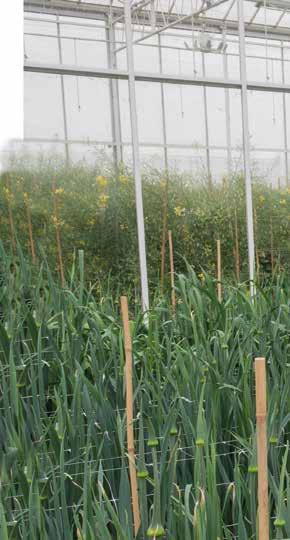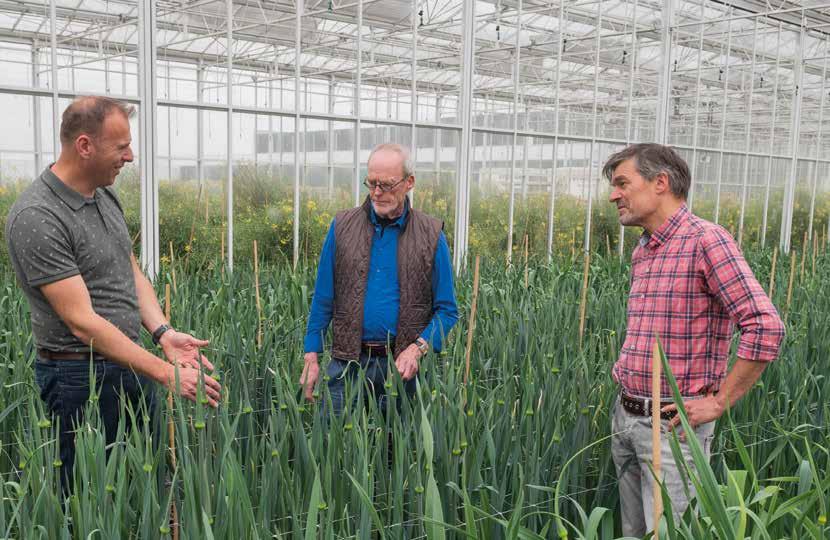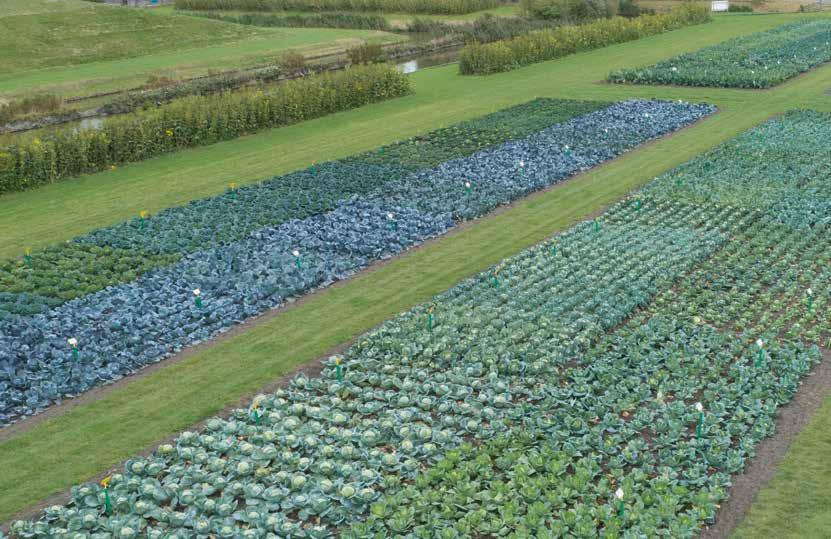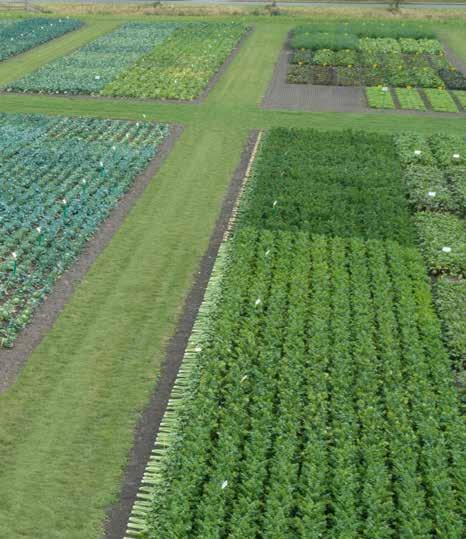
5 minute read
PIONEERING SINCE THE 1990S
BEJO’S ORGANIC BUSINESS UNIT CONTINUES TO DRIVE INNOVATION
PIONEERING SINCE THE 1990S
SEED DISINFECTION WITHOUT CHEMICALS. ONIONS THAT ARE RESISTANT TO DOWNY MILDEW. THESE ACHIEVEMENTS MAY BE OLD NEWS AT BEJO TODAY, BUT 30 YEARS AGO THEY WOULD HAVE SEEMED IMPOSSIBLE. HISTORY SHOWS THAT OUR ORGANIC ACTIVITIES HAVE ALWAYS DRIVEN INNOVATION. AND THEY CONTINUE TO DO SO TODAY, AS CONVENTIONAL FARMING STARTS LOOKING MORE AND MORE LIKE ORGANIC.
Bejo first got involved in organic agriculture back in the 1990s. In the previous decade, the world had started to wake up to the importance of sustainability. People had become more aware of the environmental effects of pesticides and fertilizers. Against this backdrop, the market for organic and biodynamic vegetables had cautiously developed. The first growers were small, and their goods reached consumers mainly through natural food stores, farm sales and farmers’ markets. In the 1990s, it became clear that organic was going to outgrow this niche. Some growers decided to scale up their production. Consumers were becoming more familiar with organic products, and mainstream supermarkets began to see value in organic ranges.
Bejo gets in early
“Ger Beemsterboer, the managing director at the time, was convinced that the trend would continue,” says Dick van der Zeijden, then Sales Support Manager. “He said, ‘Growers are going to need organic seed, and we need to make sure we’re able to provide it.’” Van der Zeijden was involved in Bejo’s organic activities from the beginning. He retired years ago but continues to serve as an advisor for the company.
“We wanted to stick to hybrid breeding at all costs.”

Dick van der Zeijden fltr: Bart Kuin, Dick van der Zeijden and Bram Weijland
Hybrid varieties
In those early days, the preconditions for organic production were still being worked out. For example, there was debate around hybrids. Some argued that using nonhybrid varieties should be a requirement. For Bejo, that would have been a no go. “We wanted to stick to hybrid breeding at all costs,” Van der Zeijden says. “It allows you to make much faster progress on qualities like resistance and uniformity.“
Organically produced seed
Organically grown seeds weren’t available at first, so growers used conventionally produced ones – non-chemically treated (NCT), of course. To create a fully organic production chain, seed growing had to change.
Bejo started thinking about that in the 1990s, and soon it was producing its first organic seeds. But “the market was still in wait-and-see mode,” says Bart Kuin, Head of Crop Management and chairman of the Bejo Organic Business Unit. “Growers weren’t sure if organically produced seeds would be of the quality they were used to. They didn’t want to compromise on purity, germination capacity or seed health.” Questions were also raised internally, Kuin says. “Setting up organic seed production separately alongside conventional was a complex, expensive change. Cabbage, carrots and onions posed an additional challenge because they take two years to produce seed. And it wasn’t without commercial risk. Would growers be motivated to choose organic seeds if they could use cheaper NCT seeds instead?”
The first demo field
Around the turn of the millennium, the decision was made, and Bejo committed to investing in organic production as a fully fledged >>

“Organic will continue to play that important pioneering role.”
Bram Weijland business activity. Fred van de Crommert was appointed Project Manager in 2000. Bejo set up its first organic demo field the same year, on the grower Jan Schrijver’s property in Warmenhuizen. Organic officially became a business unit in 2002. By then Van der Zeijden was leading the department. “The message from the board was clear,” he says. “Yes, we can do it, and yes, we need to. Organic isn’t secondary, it’s a fully fledged activity.”
Mutual enhancement
Organic seeds saw healthy sales growth from the beginning. On the other hand, substantial investment had to be made in production, processing and treatment. Research and recruitment were also necessary. As a result, it took longer than originally estimated for the organic operation to break even. “Aside from the direct increase in operating profits, the value lies in the dynamic,” says Bram Weijland, Organic Affairs Coordinator at Bejo. “Our organic and conventional activities enhance each other. Learning to grow crops without chemical pesticides and artificial fertilizers has proven valuable in conventional production and breeding too. In organic cultivation, resistance to diseases and pests is important, but above all, you need robust varieties that yield good end results even under disease and infestation pressure. And those qualities are also useful in conventional production.”
Innovation
The interplay between organic and conventional also encourages innovation in the area of seed processing and treatment. As an example, Weijland mentions non-chemical seed disinfection. “Hot water treatment was known about but rarely used because it was so much more expensive,” he says. “But organic suddenly spurred further development.

“The big challenge will be supplying enough seed.”
Bart Kuin
Today, what started out as a method involving baskets in a hot water bath is a fully automatic system. And it’s showing its value for conventional seed too.“
Organic can also drive innovation when it comes to the development of resistant varieties. Bejo and De Groot en Slot developed the first organic onion with a high resistance to downy mildew – a breakthrough. The variety, Hylander, also met demand from conventional growers, as did its successor Redlander, a red onion variety.
A mature market
Today, the production and sale of organic vegetables has developed into a mature market in Europe and North America. Governments are embracing the sector and seeking to promote it. In 2020, as part of its Green Deal, the European Commission launched the Farm to Fork Strategy, which aims to increase the amount of EU agricultural land under organic farming to 25 per cent by 2030.
Laws on organically produced seed
Bejo expects demand for organic seed to continue to grow steadily. The EU mandates the use of organically produced seed in organic crops. While derogations allowing the use of NCT seed for some crops can still be obtained, they are set to be withdrawn in 2036. Kuin says, “The big challenge will be supplying enough seed, not only in terms of volume but also in terms of the quality and breadth of the range. We’re all working hard on that.”
Organic: still pushing the envelope
Meanwhile, conventional crops are changing too. Bejo believes there’s room for two distinct, perfectly complementary market segments. Weijland says, “We expect conventional agriculture to continue to get more sustainable. It’s already using less and less artificial fertilizer and chemical pesticide. As conventional farming moves in the direction of organic, organic will go a step further. Both types will continue to reduce pesticide use, and the organic sector will focus even more on resilient varieties and cropping systems. And so it will continue to play that important pioneering role.”










